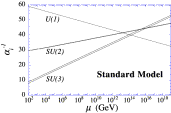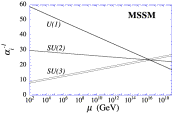Supersymmetry: Difference between revisions
ElwinMartin (talk | contribs) (I took and rewrote the intention of the basic statements so that they were at least nominally correct. This page needs a lot of work.) |
ElwinMartin (talk | contribs) No edit summary |
||
| Line 1: | Line 1: | ||
==The Main Idea== | ==The Main Idea== | ||
Revision as of 00:14, 8 February 2016
The Main Idea
Supersymmetry is the (postulated) existence of one-to-one correspondence between fundamental fermions and fundamental bosons (R-symmetry). This proposed symmetry has not been observed, but could hold true at higher energies than presently observable. [1] [2] [3]
Consequences of Supersymmetry
Supersymmetry, at minimum, doubles the number of standard model particles as there are no particles in the standard model which could be superpartners. Adding a single Higgsino results in gauge anomalies; as such a second Higgs doublet is required. Supersymmetry may also provide a means for unifying the strong and electroweak force.
In the first graph above you can see that in the standard model without supersymmetry at high energies the three couplings do not unify. In the graph to the left of that however you can see that with supersymmetry the three couplings may converge at some high energy scale. Supersymmetric partners may be one of the constituents of particulate dark matter.
Connectedness
This is extremely fascinating to me even though there is no real connection to my major, and there are no industrial applications because these tiny particles have extremely large-scale ramifications such as our understanding of gravity and how and why certain natural phenomena such as black holes and galaxies exist as they do. I think it is really cool because for most people this is just curiosity for curiosities sake. If super partners were discovered it would never have any impact on my life other than understanding why we have gravity or other forces.
History
Hironari Miyazawa was the first person to propose supersymmetry, and his was relating mesons and baryons. Because of how broken his symmetry was, his work was largely ignored. 2 groups of scientists all independently began working on a supersymmetry in quantum field theory around the same time, J. L. Gervais and B. Sakita(1971), Yu. A. Golfand and E. P. Likhtman(1971), and D. V. Volkov and V. P. Akulov(1972). The Gervais-Sakita works arose because of an early version of string theory. The model proposed by Pierre Fayet known as the Minimal Supersymmetric Standard Model was the first realistic model in superstring theory proposed.[1] [3] [4]
See also
Einstein's Theory of General Relativity
Elementary Particles and Particle Physics Theory
Further reading
Books, Articles or other print media on this topic
External links
[1] Wikipedia.en
[2] Introduction to Supersymmetry by Hitoshi Murayama
[3] String Theory and Supersymmetry for Dummies
[4] Supersymmetry by Christine Sutton
References
https://en.wikipedia.org/wiki/Supersymmetry http://hitoshi.berkeley.edu/public_html/susy/susy.html http://www.britannica.com/science/supersymmetry http://www.dummies.com/how-to/content/string-theory-the-history-of-supersymmetry.html

